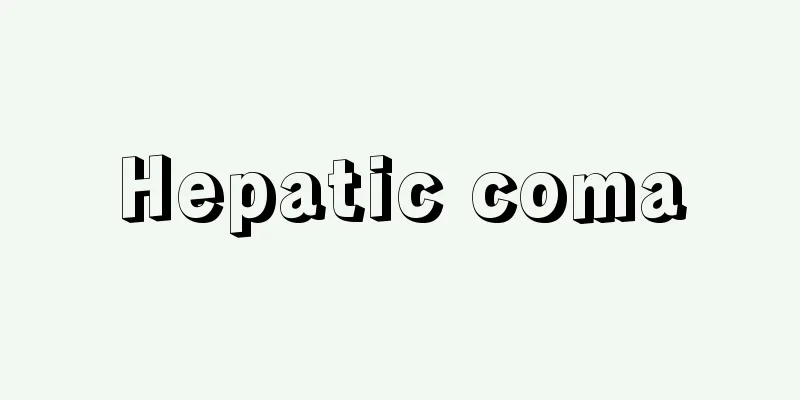Hepatic coma

|
This refers to impaired consciousness caused by severe acute or chronic liver failure. In acute liver disease, fulminant hepatitis is often the cause, and the prognosis is poor. However, in chronic liver disease, such as cirrhosis, the prognosis is not necessarily bad, and it is not uncommon for the patient to wake up and return to their previous state of consciousness. Hepatic coma is divided into four or five stages depending on the degree of impaired consciousness. The first stage is a general decline in mental activity that is barely noticeable, and patients often only realize they have had symptoms at this stage after the condition has progressed. In the second stage, the patient becomes drowsy and exhibits abnormal behavior due to loss of orientation. In the third stage, the condition progresses further and the patient may experience hallucinations. The patient sleeps most of the day, but will respond if called out loud. Attacks of impaired consciousness seen up to this stage are sometimes called hepatic encephalopathy. In the fourth stage, the patient falls into a so-called coma and only slightly responds to pain stimuli, and in the fifth stage, the patient enters a deep coma and does not respond at all to pain stimuli. The causes of acute liver failure are a lack of hepatic factors secreted by the liver that are necessary for maintaining brain function, and a decline in the liver's detoxification function, which causes toxic substances to increase in the blood and decrease brain function.On the other hand, in chronic liver failure, the prevailing theory is that a collateral portal vein blood flow (short circuit or shunt) occurs inside and outside the liver, which allows toxic substances (such as ammonia) produced in the intestine to enter the general circulation without being detoxified by the liver, impairing brain function. Treatment for acute liver failure involves plasma exchange therapy. For chronic liver failure, the cause (such as gastrointestinal bleeding) is removed, and the digestive tract where ammonia is produced is cleaned and branched-chain amino acid preparations are used. [Yasuyuki Ohta and Moriichi Onchi] [References] | | | |Source: Shogakukan Encyclopedia Nipponica About Encyclopedia Nipponica Information | Legend |
|
重篤な急性または慢性の肝不全によっておこる意識障害をいう。急性の肝疾患では劇症肝炎による場合が多く、予後不良である。しかし慢性の肝疾患、たとえば肝硬変による場合はかならずしも予後は悪くなく、覚醒(かくせい)して以前の意識状態に戻ることも少なくない。 肝性昏睡は、意識障害の程度によって4~5段階に分けられる。第1度は、ほとんど気づかれない程度の精神活動の一般的低下で、進行してからのちにこの段階の症状が出ていたことに思い当たる場合が多い。第2度では、傾眠傾向が現れ、見当識の低下による異常行動がみられる。第3度では、さらに進行して、幻覚があったりする。患者はほとんど1日中寝ているようになる。しかし、大声で呼んだりすると反応する。この段階までにみられる意識障害発作に対して、肝性脳症とよぶことがある。第4度は、いわゆる昏睡状態に陥り、痛み刺激にわずかに反応する程度で、第5度は、深い昏睡に入り、痛み刺激にもまったく反応しない状態をさす。 原因は、急性肝不全の場合は、脳機能維持のために必要な肝臓から分泌される肝性因子の欠乏と、肝臓の解毒機能の低下により中毒性物質が血中に増え、脳機能が低下するためである。一方、慢性肝不全の場合は、肝内や肝外に門脈血流の副血行路(短絡またはシャントshunt)を生じ、そのために腸管内で生じた毒性物質(アンモニアなど)が肝臓の解毒作用を受けずに大循環に入り、脳の機能が障害されるという説が有力である。 治療としては、急性肝不全に対しては血漿(けっしょう)交換療法が行われている。慢性肝不全に対しては、誘因(消化管出血など)を除去し、アンモニア発生がおこる消化管の清浄化や分枝鎖アミノ酸製剤を用いる。 [太田康幸・恩地森一] [参照項目] | | | |出典 小学館 日本大百科全書(ニッポニカ)日本大百科全書(ニッポニカ)について 情報 | 凡例 |
<<: Temporary Tariff Measures Act
>>: Inertial navigation system
Recommend
Standard of living
An indicator and concept that indicates the actua...
Hiirotake (Scarlet Mushroom) - Hiirotake (English spelling) Trametes sanguinea
Basidiomycetes, order Aphyllosteganales, family Po...
Tooth - は (English spelling)
A hard tissue structure exposed in the oral cavit...
Social reform
Social reform or social revolution, which aims at ...
hospitality
...This is because it is believed that an unbreak...
zebra danio
...It is best to keep them in groups. (d) Zebra d...
Kingdom of Kakhetia
… The 18th century was a crucial period for Georg...
Yuan Shao
One of the heroes of the late Eastern Han Dynasty...
Hunger pains
Pain in the upper abdomen that occurs when you are...
Kim Satkat
1807‐63 A wandering poet from the late Yi Dynasty ...
Ribalta, Francisco
[Born] 1565 Castellon de la Plana [Died] January 1...
Mannesmann [company] - Mannesmann
A major German integrated steel manufacturer known...
Holy numbers
A number that has a special meaning in a religious...
Regional Plan Association
…In line with this proposal, the British governme...
General Treaty for Renunciation of War as an Instrument of National Policy
Officially, it is called the "Pact for the Re...




![Shimane [town] - Shimane](/upload/images/67cbca3f27c2f.webp)




